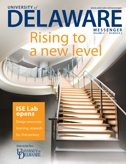Milestone celebrated as electric cars generate revenue

RESEARCH | Research at UD, through a project in partnership with NRG Energy Inc., has proved for the first time that all-electric vehicles can give and take power from an electric power grid and get paid for the service.
Located on the University’s Science, Technology and Advanced Research (STAR) Campus, 15 vehicles officially connected with the grid in February. Since then, they have operated as a mini power plant, giving and taking electricity on demand.
“It’s a certified, registered electric system resource that has all of the legal authority of a power plant,” says Willett Kempton, professor in the College of Earth, Ocean, and Environment (CEOE), research director for the Center for Carbon-free Power Integration and inventor of the innovative grid integrated vehicle technology.
The success of the electric vehicle-to-grid technology is an important new tool for stabilizing the nation’s electricity supply and developing energy independence, researchers say. Currently in the U.S., as demands on the electricity system fluctuate, large generators ramp up and down quickly to adjust for the changes and to balance electricity supply and demand.
“We serve that same function,” Kempton says of the fleet of electric vehicles. “It’s an important service, this balancing service. It’s not a new service, but we are doing it in a very different way. Our system responds faster, is less expensive to operate, and it does not burn fuel or create pollution.
“The batteries [in each car] are storage devices, so we can take off excess electricity and we can push back when there is not enough. We are providing a power balancing service rather than power generation.”
The electricity stored in the vehicles’ batteries is controlled and aggregated by a centralized server.
Kempton’s vision for grid-integrated vehicles began in 1997 when he and a UD graduate student published a paper about the technology. After doing much of the initial development himself, Kempton says he realized that his dramatically different plan bridging three industries—automotive, energy and electronics—needed more than academic publications to be realized. It required a dedicated campaign that included gaining support from the state legislature, changing public policies and building strong partnerships.
To further develop Kempton’s technology and assess its technical and business potential, UD’s Office of Economic Innovation and Partnerships worked closely with the University’s Office of General Counsel to help form a partnership with NRG, one of the nation’s largest power generation and retail electricity businesses.
Partnerships have been a hallmark of the project, including collaborations with BMW AG, electric grid operator PJM, automobile retrofitter AutoPort Inc., and Milbank Manufacturing Co. CEOE’s School of Marine Science and Policy helped advance necessary public policy changes and supported Kempton’s research, and the College of Engineering developed electronics for some of the vehicle-to-grid functions.
“This electric vehicle project is an excellent example of how academic research can foster benefits to both society and the environment,” says Nancy Targett, dean of the College of Earth, Ocean, and Environment.
Article by Laura Gleason, AS87






